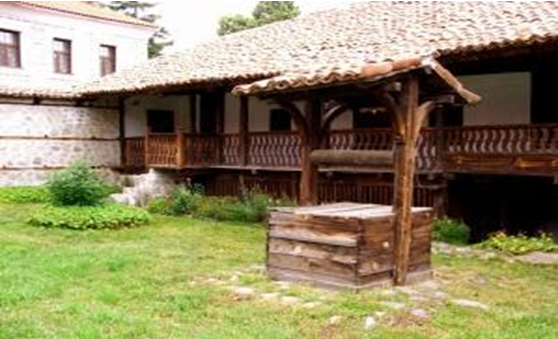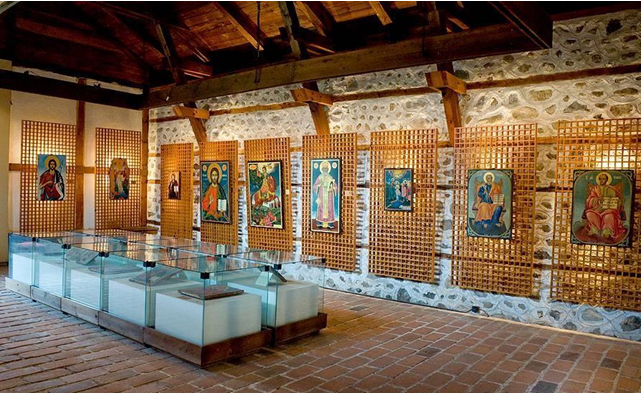Rila nunnery Bansko
Еach settlement has its own natural, cultural or historical landmarks. There are settlements that have incredibly beautiful nature and are proud of it, there are towns and villages that preserve an abundant cultural and historical heritage and for which the preservation of traditions is a priority # 1.
And there are towns like Bansko to which God seemed to have given everything. The town has uniquely beautiful nature, but it also has numerous cultural and historical landmarks and it is extremely difficult to tell about each of them.

The sights that are worth visiting in Bansko are really many, but we want to tell you about a specific one. We have chosen to introduce you to theBansko nunnery, because only there you can see some of the most exciting and unique works of icon painters from theBansko Art School.
Rila nunnery Bansko – the place where history, faith, spirit and contemporaneity meet
The history of the Rila Nunnery begins in the middle of the XVIII century, when a magnificent, one-storey building was built in Bansko to serve as a nunnery. The year of construction of the building is known with precision, because during its construction the masters wrote the year above the entrance to the nunnery… 1749. Originally, the Nunnery belonged to the Hilendar Monastery and was part of it until the end of the XVIII and the beginning of the XIX century.
At the beginning of the XIX century, however, the Hilendar Monastery became Serbian and the nunnery became part of the Rila Monastery. During the times when it was active, the nunnery played a very important role in the history of Bansko during the Bulgarian Revival Period. The nuns who lived in it performed not only spiritual but also charitable and educational activities.
There was amonastery schoolto the monastery in which the children from Banskohave learned reading and writing. In addition, the nuns helped disadvantaged girls by teaching them all useful female activities such as cooking, embroidering, knitting, weaving, sewing, and more.
After the Liberation, the Rila nunnery in Bansko ceases to operate, but its magnificent building was preserved. Its purpose has not been clear until the XX century, but from the mid-1980s to the present day, the building houses some of the most impressive examples of icon painting of the Bansko Art school.
The iconic exhibition in Bansko
History of the idea of the exhibition
The idea to open a permanent icon painting exhibition in Bansko arises thanks to the international symposium “Bansko – Art Center”, which was held in the town in 1985. During this symposium, an exhibition was prepared, presenting original works of icon painters from the Bansko Art School.
The exhibition was so successful that the following year (1986) people decided to make it permanent and the buildingof theRila nunnery in Bansko was chosen as its home. Since then, anyone who wants to get acquainted with the incredible mastery of the iconpainters of Bansko can do so by entering one of the oldest buildings in Bansko.
What treasures does the Permanent icon exhibition in Bansko hold?
The exhibition is housed in a total of 6 halls (four smaller and 2 large ones) and presents the development of one of the most impressive manifestations of Bulgarian icon paintingfrom the end of the eighteenth to the end of the nineteenth century – the Bansko Art School.
In the exhibition halls can be seen the original works of the founder of the BanskoArt School – TomaVishanov – Molera, as well as the works of his heirs – his son Dimitar and his grandson – Simeon, and of some of his most famous followers – DimitarSirleshtov, MihalkoGolev, Angel Veliyan, GeorgiBoboshevski and others.
Why it is worth visiting the Permanent Icon Exhibition?
Even if you are not a fan of the fine arts and icon painting, you will certainly not be disappointed when you see the works of masters from the Bansko Art School. This art school is the first school to make a change in the strict canons of the icon painting.
The masters of icon painting have used European styles in their works such as baroque and rococo, and in their icons can be noticed more secular motifs, airiness, bright colors striving for depiction of secular images. The founder of the Bansko Art School – Toma Vishanov was also the first Bulgarian artist to use perspective in the painting of icons.

In addition to icons, the exposition of the exhibition can see donor’s portraits of reputable local residents and photocopies of murals, works by masters of the Bansko Art School, church sacred vessels and others.
In 2013, the Rila Nunnery in Bansko was included in a project called “Bansko – the Crossroads of Civilizations”, thanks to which a complete restoration and renovation of the building was carried out, the exhibits were restored and preserved, and also an access for people with disabilities was provided.
„Bansko–the crossroad of civilizations” or how the town preserves its history
We have all visited tourist sites in the country that seem to be abandoned at the mercy of nature. We have seen unique buildings, monasteries, churches that are in a process of destruction and disappear with each passing year, leaving no trace. Fortunately, people in Bansko not only preserve their history and traditions, but also its landmarks.
The Bansko – Crossroads of Civilizations project aims not only to restore some of the most valuable tourist sites in the town, but also to make them more accessible and even more desirable and attractive to tourists.
The project started in 2013 under the program “Regional Development of Bansko” and its main purpose is to support the development and diversification of tourist attractions. In addition to the Rila Nunnery, the project also includes:
- Velyanova house
- „Sitan kale” fortress
- St. Nicholas Archaeological Reserve
- Visitor Information Center in the town
Velyanova house
Built in the XVIII century, the Velyanova House is one of the most impressive examples of Bansko reinforced house. The house was owned by Veliyan Ognev, a master painter from the Debarsko art school, who settled and married in Bansko. The house is unique and magnificent with its austere construction style, with its incredible woodcarvings and with its rich wall decoration.
Thanks to the Bansko – Crossroads of Civilizations project, today any visitor who walks through the gates of the Velyanova House can admire the renovated unique murals, see the intricately carved woodwork and enjoy the view that opens from the veranda.
All the murals in the Velyanova house have been renovated, preserved and brightly colored, so they look the same way as they looked at the time Veliyan Ognev and his family lived there. In addition to the renovation and conservation of carvings and murals, the Velyanova House has access for people with disabilities.
“ST. Nicholas” archeological reserve
Located on a steep slope in the southeastern part of Pirin, the archeological reserve “St. Nicholas” provokes great interest among tourists. The complex has not yet fully revealed its secrets, but what archaeologists have so far found is worth a visit.
On the territory of the archeological complex can be seen parts of the fortress wall and watchtower, foundations of residential premises and a large number of artifacts from different eras. After the renovation, conservation and provision of easy access under the “Bansko – Crossroads of Civilizations project”, the St. Nicholas Archaeological Reserve attracts tourists from around the world.
„Sitan kale” fortress
The late antique fortress “Sitan Kale” was one of the largest and very important strongholds in ancient times and was of strategic importance. The fortress was large and strictly guarded. Both the preserved parts of thick fortified walls and the remains of the four guard towers, located at the four corners of the fortress, are evidence of the defensive power of the fort.
„Sitan kale”is present in the legends and stories of the local people as the center of their resistance against the Ottoman invaders. There are not one or two legends about the majestic fortress that tell of the power of the people of Bansko, who were ready to defend the fortress at the cost of their lives.
Until 2013, a visit to the fortress was difficult to accomplish, but today anyone who wants to explore the fortress can do so easily and seamlessly. Wooden stairs lead to the fortress walls, making it easy to climb. There are designated places for rest and relaxation, which reveal wonderful views of the mountains and Bansko.
Visitor information center – Bansko
The building that houses the Information Center today was built in 1924. As part of the Bansko – Crossroads of Civilizations project, the building has been renovated and restored, and a modern center for online communication with all sites under the Regional Development Program has been established.
Today the Visitor Center is the first place visited by tourists who want to learn more about Bansko and its incredible sights.

How would a visit to the Rila nunnery be helpful to you?
The truth iswe can’t tell you thatyou must visit the building and see the iconic exhibition. We won’t even try to do that. But if you are curious to open the heavy gates of the nunnery and step into its yard, we assure you, you will be very fascinated. You will be delighted by the beautiful architecture of the building typical for the Bulgarian Revival Period, you will feel incredible peaceful as you pass through the wide, spacious yard and go back in time when you enter and stand in front of one of the authentic icons of the founder of the Bansko Art School – Toma Vishanov – Molera.
Be sure that you can not find in no other corner of our country such a perfect symbiosis between the architecture of the building and the exhibits that are presented in it. Nowhere else will you be able to enjoy the beautiful, uniqueicons, work of the painters of the Bansko Art School.